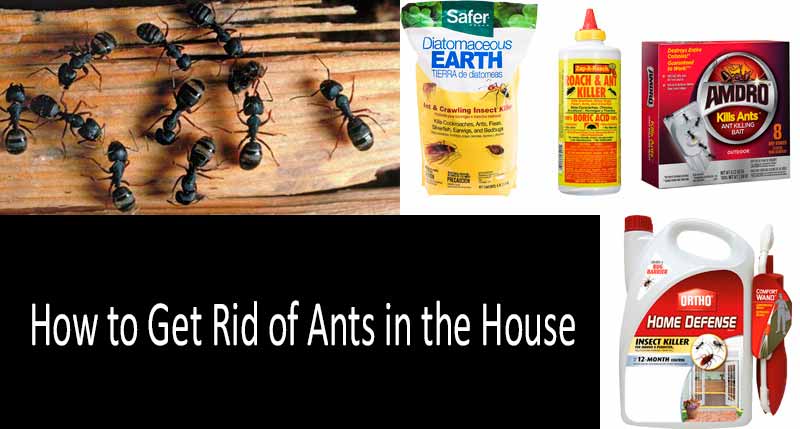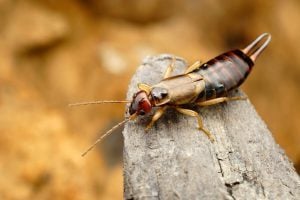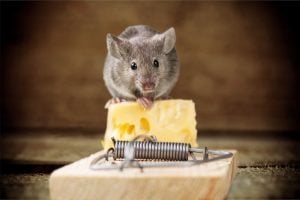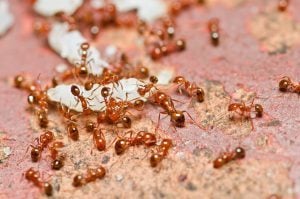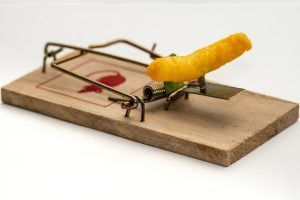The internet is full of users’ tips on using duct tape, flour or talc, pouring salt or ground pepper on pests’ potential entrance places so that the insects can’t enter your house. Such tips are usually published on entertainment websites and have nothing to do with real insect extermination. Ants are not as simple as they seem at a first glance. Their food preferences are finicky, so it is essential to use appropriate baits. It is absolutely useless to kill foragers that you find in the kitchen because you should kill the queen. Do you know what to do if they settle in a wall void? We’ll answer these questions. When composing our review, we relied on studies made by the experts of various American universities and experienced entomologists. The second half of the review lists the top 11 best indoor ant control products from natural ones and baits to liquid insecticides.
Table of Contents:
- Know Your Enemy: Ants in the House
- A Review of Scientifically Proven Treatments
- 11 Best Products to Get Rid of Ants in the House
Know Your Enemy: Ants in the House
Throughout history, humans travelled and migrated from one continent to another. Animals that live side by side with people also travelled and migrated with them. They parasite on humans or simply impose themselves in their accommodation, steal food, damage furniture and crops. Such animals (most of them are insects) are called synanthropic. Species that have inhabited a new continent or an island in the course of following humans are called invasive. There is a great number of synanthropic and invasive ant species, and some of them live directly in the house or are closely connected to it.
Where Can You Find an Ant Nest in Your House?
When ants are seen crawling around the kitchen and in storage places, many people are perplexed as to where these insects come from. Their nest can be found both outdoors and indoors near human food. These pests can nest in several places in your house:
- In the wall voids
- In plant pots
- Under the skirting boards
- Inside the furniture
- In paper or fabric piles, for instance, in the wardrobe or old clothes that have not been sorted for a long time
Let’s study the eight species that are considered household ants according to the University of California. Before that, note the following. When people encounter these pests near sweets in the kitchen, they call them sugar ants. There is no such species; people give this name to any sweet feeders, including carpenter, odorous house and other ants that are attracted primarily by sweets and sugar.

Carpenter ant — Camponotus spp. Black and black-reddish workers can reach ¼-½ of an inch in length. If you disturb them, they will exude a typical odor. They feed on insects, aphids’ secretion, fruit nectar and other sweets. Camponotus spp gnaw trails and galleries in dry wood where their colony settles. Initially, their presence goes unnoticed, and you are likely to notice them only once substantial damage to your property has been done. We’ve covered more details about this species and explained how to get rid of them in our article “How to get rid of carpenter ants”.
Odorous house ants – Tapinoma sessile. The workers are dark brown or black and can reach ⅛ of an inch long. They exude a strong smell if crushed. They feed on insects, aphids’ secretion and sweet foods. They lay their trails along tree branches, house foundations and skirting boards, along the wiring and pipes and carpet edges. They tend to live in the soil under stones, fallen trees or garbage. In the apartments, they build nests in house walls, around water pipes and heating pipes. Their colonies are usually large and can number up to 10 thousand insects with many queens.
Pavement ants. Adults are dark brown or black, 3/16 of an inch long. They feed on sweets and insects and can also get in food rich in fats. They won’t spurn pet food and their activity peaks at night. Their mounds are located in turf, under stones, wood or paving tiles and small anthills can be found near water sources. A colony has one queen, different colonies are at war.
Argentine ants. Their workers are dark brown and ⅛ of an inch long. When crushed, they exude an odor. They feed on sweets, fruit, some flowers, aphids’ secretion and food rich in fats. Their trails are usually formed along pavements, buildings, tree branches, skirting boards and carpets. In the summer, some insects leave to create a sub-colony. Various colonies are not at war with each other. They nest under trees, in the ground, garbage, mulch or tree voids.

Pharaoh ants are yellow, 1/16 of an inch in length. They feed on live or dead insects and are quite omnivorous. If they penetrate a human house, they can reach practically any food. They create their trails along the furniture, skirting boards and carpets; they prefer to be as close to water as possible. The colonies are quite mobile. Workers can migrate to a safer and more appropriate place when needed along with their larvae, pupae and queens. An ant nest can appear in the walls and inside the furniture, behind the skirting boards and home appliances and even in clothes and paper. The colonies are large; they can reach up to 300 thousand individuals and several queens.
Red imported fire ant is distinguished from the above mentioned species by their polymorphism. The dark-brown representatives can reach up to 1/16 inches in length depending on their activity. They have a sting and are extremely aggressive. They feed on live and dead insects and collect secretion from producer insects. At home, they taste various goods containing fat and protein. If you disturb their colony, its inhabitants will attack the aggressor and bite them painfully. They move along buildings, skirting boards and carpet edges and can even carry their nest elsewhere. They settle in sunny places near water sources and build mounds of up to 18 inches tall, although they can also settle in the building’s wall voids. Up to 500 thousand individuals can inhabit a single colony.
Southern Fire Ant is yet another species where the workers’ length varies from ⅛ to ¼ of an inch long. These insects’ head and chest are amber, the belly is black and the body is covered with golden hairs. They feed on insects, sweet, fat and protein-rich food; they consume seeds, almonds, fresh bark and nectar. Their activity peaks in the morning and evening. They use painful bites as a defense against aggression. Their colonies are built in hummocks or loose soil near water, as well as under rocks and planks. They settle in wall voids indoors. A single colony can be inhabited by up to ten thousand individuals, including several queens.
Thief ants are tiny (only 1/32 of an inch long) and have yellow or light-brown bodies. Their diet is rich in fats and proteins; they consume dead insects and rodents and sometimes resort to sweets. They steal food and larvae from other colonies. Also, their size allows them to penetrate even packed food. Outside they live in the soil and under stones, and indoors they are found in the wardrobes, inside the walls or behind the skirting boards. Several queens can live in one colony.

A Review of Scientifically Proven Treatments
As it becomes apparent from the description of various ant species, household ants can settle practically anywhere where there is access to food and water. That is why the scientists lay special emphasis on the importance of keeping the house and surrounding areas clean when getting rid of unwanted ants.
Check the rooms regularly and pay special attention to idle ants. They are most likely foragers who will surely bring others along once they find a source of food at your house. Foragers are the ones who will lead you to the nest.
The mistake most people make when attempting to control ants is only spraying the ones they see. This approach usually fails because the ants seen foraging over exposed surfaces are only a small portion of the colony. Typically, there will be thousands of additional ants, including one or more egg-laying queens hidden somewhere in a nest. Eliminating queens and other colony members within nests is often the key to effective ant control, as the University of Kentucky experts claim.
In order to eliminate all the queens, slow-acting baits described below are necessary.
Baits
Getting rid of these pests with baits is the most effective and scientific method. Its advantages are neat use and no necessity in leaving the house as you would have to when carrying out pest control. Its disadvantages are slow action which is the key to its effectiveness.
Once a worker takes a piece of bait poisoned with a slow-acting substance, it will carry it to the nest to share with other individuals. Gradually, the poison reaches the queen. Without her the colony won’t survive as nobody would be able to reproduce. The process can take up to several weeks, but initial results (i.e. insect population reduction) will become apparent within a few days.

The University of Kentucky specialists warn that these pests «are rather finicky in their food preferences and may alter them throughout the year. If one bait product isn’t attractive or doesn’t seem to be working, try another. Optimal results usually require a sustained period of feeding, not just a brief visitation by a few ants».
Different Ant Species Require Different Baits
Baits can be carbohydrate, protein or fat-based and act on various ant species depending on the season and the victim’s preferences. Carpenter ants and odorous house ants prefer sweet baits while pavement ants are omnivorous. Argentine ants are satisfied with sweet bait all year around and enjoy proteins only in spring. Pharaoh and thief ants, on the other hand, prefer protein and fat bait all year. Fire ants are attracted by oils. Indoor and outdoor baits are a separate matter. If the ants enter your house from the outside, you’d better not use indoor baits.
| Ant Species | Effective Treatment | Active Ingredients |
| Pharaoh | Combination fat-based baits with sweets are more effective for a longer period of time than using sweet baits alone. | Hydramethylnon, sulfuramid, boric acid and fipronil |
| Thief | Protein baits are somewhat effective if changed often enough. Place outdoors. | hydramethylnon and fipronil |
| Southern fire | Granular products must be placed outdoors, most effective if applied in the evening | fipronil, hydramethylnon |
| Pavement | Sweet baits such as boric acid (low concentrations with less than 1% active ingredient) and protein baits. | fipronil, hydramethylnon |
| Carpenter | Boric acid baits that have a low concentration (less than 1%) of the active ingredient in a sweet liquid. | Boric acid |
| Odorous house | Sweet baits such as boric acid, may sometimes feed on protein baits. | fipronil, hydramethylnon |
| Argentine | Sweet sugar baits throughout the year, protein baits are attractive to ants in spring. | fipronil, hydramethylnon, boric acid |
Source: University of California

Special attention is paid to red imported fire ants as it is strongly recommended that you consult professional exterminators once you discover them at home instead of attempting to get rid of these parasites on their own. Here is what the University of California experts inform you of: «California currently has a program aimed at eradicating the red imported fire ant within the state. Therefore, homeowners should not attempt their own control measures. Any suspected infestation should be reported using the statewide toll free number that has been set up by the California Department of Food and Agriculture for this purpose (1-888-4FIREANT). There is also an informative Web site. Once contacted, state personnel will determine if the ants are red imported fire ants and if so, will apply approved treatments free of charge or recommend a course of action». In order to find out how to get rid of red imported fire ants, refer to our review devoted to the Top-17 fire ant killers
If the ants live in the walls and have formed a colony in the wall voids, some boric acid will be handy. This basic treatment is used not only as bait ingredient, but also as a dust. To destroy a colony, spray some boric acid inside the wall.
As the Texas A&M University entomologists advise,, nests in wall voids also can be treated by injecting aerosol through cracks and crevices and around baseboards. If nests cannot be located, toxic baits can be effective when placed on foraging trails.
How to Get Rid of Ants in the House Naturally
Natural products are as widely used as synthetic ones. One of them affects parasites once in contact with their bodies. We are talking about diatomaceous earth, i.e. flour made of diatom algae fossils. The particles of this substance have sharp edges that are harmful to insects. Diatomaceous earth is absolutely safe for pets and humans. Unfortunately, it is ineffective when you need to eliminate the nest completely but will be helpful for population control.
The experts from the University of Clemson consider limonene to be an effective insecticide: «Limonene is produced from citrus oils extracted from oranges and other citrus fruit peels. It is used as a contact insecticide against ants, roaches, palmetto bugs, fleas, silverfish and many other insects. Limonene has low oral and dermal toxicity to mammals, birds and fish, although it can cause skin irritation or sensitization in some people. Pesticide products containing limonene are used for flea and tick control on pets, insecticide sprays, outdoor dog and cat repellents, mosquito larvicides, and insect repellents. Many products containing limonene are labeled as safe for use in areas near food».

Eugenol, which is a clove essential oil ingredient, is also well-known and used against many insect and spider species, including herbivorous pests. It irritates the skin and mucous membranes and should be used only when wearing protective gloves and goggles. It is often combined with sesame, thyme, rosemary and other oils.
How Ant Killers Work
| Type | Active Ingredients | Action | Best Use |
| Liquid insecticide | Bifenthrin, Gamma-cyhalothrin, Deltamethrin | Kills on contact and creates a protective barrier around the house. | Use outdoors or indoors. Pour into mounds, treat foundations and spray in the insects’ activity areas. |
| Granules | Acephate, hydramethylnon | They destroy an outdoor colony and prevent new pests from appearing. | Use outdoors for broadcast treatment, pour it around the mound and along the trails. |
| Foam and sprays | Fipronil | Will kill an inaccessible colony within a few days. | To be sprayed on nests in the walls. |
| Poison baits (bait stations) | Fast-acting: Indoxacarb Slow-acting: hydramethylnon, fipronil, boric acid (borax) |
The most effective method that can eliminate the entire colony. It is effective within 3-5 days (fast-acting), 1-5 weeks (slow-acting). | Use indoors or outdoors in the areas of insects’ activity and around their mounds. Ants are finicky and they change their preferences often so you will likely have to switch bait types several times. |
| Diatomaceous Earth | Organic insect killer | Contact action: the particles cut the insects’ exoskeleton and cause dehydration. | Use indoors, spray along the trails and in the insects’ activity areas. |
| Boric acid (dust) | Low-toxic insect killer | Slow-acting stomach poison. | Use indoors, spray along the trails, down the cracks and shelters. |
| Limonene | Citrus essential oils ingredient | Impacts the CNS, causing paralysis and death of insects. | Can be used near food. |
| Oils and Natural sprays | Clove, peppermint, geranium, cinnamon leaf oils | Contact action and certain repelling effect. | Are conditionally safe, i.e. they can be used for treating any areas and creating a protective barrier around your house. |
| IGR | Pyriproxyfen | Highly effective: sterilizes the queen and therefore will remove the colony completely. | Use indoors or outdoors: spray mounds and trails. A very slow-acting product (is effective at least after a month), so be patient. |
Top-11 Products to Get Rid of Ants in the House
Here, we’ve listed organic products, baits for destroying an entire colony along with its queen, foam for treating the walls on the inside if a nest is found there and some powerful professional insecticides.
Natural Treatments: Diatomaceous Earth, Boric Acid and Essential Oils
The most popular organic insecticides are diatomaceous earth, boric acid, limonene and eugenol. However, unlike baits, all these treatments are contact, which means they will not destroy the queen and the entire colony, but only those insects which they come in contact with.
Safer Brand 51703 Diatomaceous Earth
Diatomaceous Earth is a classic and most popular organic insect and arachnid control product. Safer Brand DE Diatomaceous Earth kills its victims on contact as it penetrates the insects’ chitinous cover and causes death of dehydration. At the same time, the product is harmless and non-toxic for pets and humans as it cannot penetrate their elastic skin. Sprinkle the places of congestion and migration of ants with this powder.
Price: Check the current price
PestGuard Zap-A-Roach Boric Acid (2-pack)
This is yet another universal cut-rate insecticide. It acts as a slow-acting stomach poison causing the insects to die of starvation. This powder-like product is placed in inaccessible or sprayed through the nest entrances in such spots, such as walls. The pests will bring the powder on their legs to the nest and will contaminate other nest dwellers. The product is also effective against roaches, fleas and silverfish. This traditional treatment has a very high customer rating – it could work for you too.
Price: Check the current price
Clove Essential Oil
Clove essential oil for Check the current price has a limited effect on insects on contact. It is also used for repelling pests. For that purpose, concentrated oil is to be dissolved in plenty of water to create a protective barrier along the outer perimeter of the house.
Caution! Essential oils are hazardous for children, pregnant women and pets, especially cats. Don’t use pure oils; dissolve them according to the manual. If there are too many insects, move on to use more powerful insecticides.
Price: Check the current price
Blubonic Industries 100% Orange Oil d-Limonene
The bottle contains 32 oz of 100% d-limonene. Its contact action causes seizures leading to paralysis and death of the insects. d-Limonene is not found separately in nature. It is made of citrus essential oils that give it the typical juicy smell. The concentrate costs Check the current price and is completely dissolved in water before use.

If you don’t want to bother making a mixture, opt for a ready-to-use spray Orange Guard 103. This spray is made especially for controlling home insects that are repelled by the citrus smell. It can be used both outside and at home. D-limonene was considered GRAS (Generally Regarded as Safe) by the United States Food and Drug Administration, and is widely used in the food industry which is why products containing limonene are labeled as safe for use in areas near food.
Price: 100% concentrated d-Limonene: Check the current price
Price: 5% d-limonene Orange Guard Spray: Check the current price
Bait and Bait Stations for Indoor and Outdoor Use
We’ve found four slow-acting baits for using indoors and outdoors for finicky ants, both sweet and protein-rich. One of them is a relatively slow-acting bait based on fipronil, which will be effective within a few days. Three others are borax and hydramethylnon-based and act slower; they take at least a week. These poisons will be able to reach and kill the queen responsible for the reproduction in the colony.
TERRO T300 Liquid Baits
A pack of 6 borax-based ant bait stations for indoor use costs only . It is extremely popular with the customers. The manufacturer claims that this sweet borax-based bait will kill all house ants. Foragers that will be attracted by the bait will carry it to the nest and share it with other colony members and, what is critical, with the queen. Borax is first and foremost a slow-acting stomach poison which is why a worker will be able to contaminate others and the queen before dying. The key thing is not to kill them or prevent them from entering and leaving a bait station as they must believe they have been lucky to find a source of a delicious meal. The colony will die as early as a week after bait installation. Borax and boric acid are considered organic and conditionally non-toxic substance; make sure your kids don’t touch the bait inside the station.
Price: Check the current price
Combat Max Killing Gel
This popular fipronil-based protein based is supplied in a syringe. This gel is supposed to be squeezed out of the syringe on any place reachable by the ants at home. As the manufacturer promises, this bait begins to act within an hour. You will be able to observe preliminary results within 3-5 days. Be prepared for repeat use – the queen will be able to revive the colony soon enough. According to the manufacturer, the product is safe for children. The users are fond of this product and give it a high rating.
Price: Check the current price
AMDRO Bait
The entire cheap Amdro line has two distinguished baits: stations for indoor use and granules for outdoor use.
Four stations with hydramethylnon-based protein bait cost Check the current price. They promise to kill the colony and the queen. The stations are to be placed indoors near the insects’ places of activity. Despite its affordable price, a single station can function for up to three months. After tha,t you can replace it with a new one, if necessary. The manufacturer promises a refund if this slow-acting bait proves useless.

Hydramethylnon-containing Amdro Home Perimeter Granules cost Check the current price. A 24 oz pack is enough for treating 1,080 linear feet of territory. The granules will kill the insects outside and won’t let them reach your house. Lay them alongside the perimeter of your house. It is broadcast treatment that is considered to be the most effective pest control method by the scientists. The granules’ customer rating is also higher than that of other stations.
Price: Amdro bait stations for indoors: Check the current price
Price: Amdro bait granules for outdoors: Check the current price
Powerful Insectaries: Foam and Spray
Termidor Foam For Wall Voids
Termidor Foam is a universal fipronil-based killing product effective against various pests. To get rid of them, spray the foam down the wall voids where a colony has settled. The foam is very dense and the ants won’t be able to overcome this barrier and survive. It is promised that they will die of fipronil within a few days. Although the product is quite expensive (Check the current price), users unanimously accept that it is effective and more affordable than hiring professional exterminators.
Price: Check the current price
Ortho Home Defense MAX Insect Killer for Indoor & Perimeter RTU Wand
This contact bifenthrin-containing insecticide is sold in a 1.1 gallon canister for Check the current price. It can be used both indoors and outdoors. The product kills ants and over 130 other pest insects including cockroaches, spiders and other household pests. The spray creates a barrier that will protect your house for up to a year, and the lot for up to three months.
It is sprayed on a dry surface. A convenient sprayer is supplied along with the killer so that you don’t have to pour the substance anywhere or mix it with water. Cleaning is allowed on the next day following the treatment. The product is very powerful, but it will only kill those parasites with which it comes in contact, so be ready for a repeat use once you notice pests on your lot again. Judging by the happy users’ feedback, having such an insecticide is very useful for amateur exterminators.
Price: Check the current price
Best Household Ant Control Products Comparison Chart
How to Prevent Ant Infestation in the House?
It is far easier and cheaper to prevent these pests from appearing at home than to eliminate the consequences of ill-considered actions.
In order not to let the pests penetrate from the outside, caulk all cracks and holes in the windows, walls, foundation, and especially around wiring and pipes. Place all you and your pets’ food in Tupperware and other containers to seal the odor. Clean your house in a timely manner as it will let you not only collect all the leftovers and crumbs, but also to remove any odors with which foragers mark laid trails. If you notice any parasites in the backyard, use bait granules to not let pests into the house.
To prevent the insects from founding a colony at your house, be even more thorough about the order: check all the wardrobes, chests and closets, don’t clutter them and check pot plants regularly. If any ants are found in the pots, place the latter in an insecticidal soap solution for about 20 minutes.
{code 416}
{code 117}

